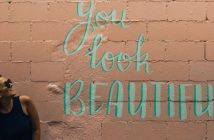
Science Snapshot:
Water and oil are not good friends – they don’t mix. Oil is less dense (meaning lighter) than water, so it floats on top. When the effervescent tablet or bicarb soda drops into the colored water, a chemical reaction begins – producing carbon dioxide bubbles. These bubbles surround droplets of colored water making them momentarily less dense than the oil. They rise up through the oil, until they hit the surface and the bubbles pop. The heavier water then drops back down through the oil to the bottom of the jar. Real lava lamps use two liquids that are very close in density, or weigh about the same, but don’t mix. The heavier liquid down the bottom is heated, which causes it to become less dense and to rise to the top of the lamp. As the heated liquid rises, it cools down, becomes more dense and starts to sink.

Materials
Large glass jar
Cooking oil
Food coloring
Water
Effervescent tablet such as Alka-Seltzer (alternatively, use bicarb soda and replace the water with white vinegar)
Time: 10 minutes
Difficulty: Easy

1 Mix the food coloring and water in a cup (if using bicarb soda use white vinegar instead of water)

2 Fill your jar two-thirds with oil and slowly pour the colored water into the jar until the liquids are 2cm from the top of the jar.

3 Wait for the oil and water to separate into two layers. This should only take a few minutes.

4 Drop an effervescent tablet(or half a teaspoon of bicarb soda) into jar, and watch your groovy lava lamp bubble away!
Ben Bravery and Tim O’Mahony work for Beijing-based Kexue Communications.They perform science shows and workshopsfor schools, birthday parties and otherfunctions. For details, visit www.kexuecommunications.com, e-mail info@kexuecommunications.com, or call 8415 5034.



